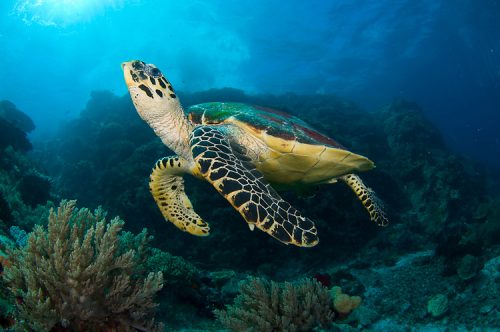The hawksbill sea turtle (Eretmochelys imbricata) is a sea turtle that is widely distributed in the Indian, Atlantic, and Pacific Oceans. It is thought to occur in the shallow lagoons or coral reefs where the turtle spends much of its daytime. The sea turtle rarely goes into the open water; it largely prefers shallow waters. Hawksbill turtles feed on sea sponges.
Hawksbill Sea Turtle Facts
Anatomy
- Like most other marine turtles, hawksbill sea turtles also possess compressed body along with the limbs that seems more like flippers.
- The length of the adult sea turtles grows about 1 m (3 ft) and they weigh up to 80 kg (180 lb).
- The background of the turtle’s shell is all patterned and there are light and dark streaks on it.
- Unlike other species, hawksbill turtle possesses hooked beak. They have sharp claws on each of the arms.
- The hawksbill’s carapace is 1 m (3 ft) long.
- They are able to crawl on land.
See also: Sea Turtle Facts For Kids

Geographic Range
- Hawksbill sea turtles occur in the Pacific, Indian, and Atlantic oceans. They are likely to make habitats in tropical reefs. imbricata is thought to survive in the warm tropical waters.
- Their range includes Gulf of Mexico, southern Florida, Long Island Sound, Massachusetts, Costa Rica, Puerto Rico, Cuba, Virginia, Japanese Archipelago, northern New Zealand, Great Barrier Reef (Australia), and the Mexican waters.
Hawksbill Sea Turtle Habitat
- They spend much of their time resting in ledges and caves as they fancy making homes in tropical coral reefs.
- Turtles rarely go more than 65 feet (21 meters) deep into the water.
- Hawksbills are thought to make homes in a wide variety of habitats such as mangrove swamps, open oceanic waters, and lagoons estuaries.
Feeding Ecology & Diet
- Hawksbill sea turtles typically feed on sea sponges as well as algae, fish, barnacles, sea grasses, urchins, and crustaceans.
- Sea sponges make up 90% of the turtle’s diet. However they are almost entirely omnivores. Hawksbill sea turtles eat comb jellies, sea anemones, jellyfish, and cnidarians.
- Caribbean turtles typically consume the orders of Spirophorida, Hadromerida, and Astrophorida.
- Prominent among the sponges are Tethya actinia, Spheciospongia vesparium, Aaptos aaptos, and Chondrilla nucula.
- Turtles are thought to eat up to 1200 lbs (544 kg) per day.
- They are migratory animals.

Reproductive Biology
- Except for breeding season, hawksbill sea turtles live most of their lives alone.
- After every 2 – 3 years female turtles return to the same nesting sites.
- Hawksbill sea turtles mate twice a year. They nest on the far off lagoons and islands.
- The mating occurs April to November but some of the turtles mate from September to February.
- Florida population lays 140 eggs in one clutch. After every 14-days interval, females lay 3 – 6 clutches each season.
- Newborn baby turtles weigh up to 24 g (0.85 oz) at birth. These dark-colored babies reach a length of about 2.5 cm (0.98 in).
- The incubation period lasts about 2 months.
- They attain maturity at 20 years age.
- We’re not sure about the average lifespan of hawksbill turtles.
- Predators of baby turtles are shorebirds and shore crabs. Adults fall prey to octopuses, estuarine crocodiles, sharks, and pelagic fish.
Conservation Status
Critically Endangered


Leave a Reply